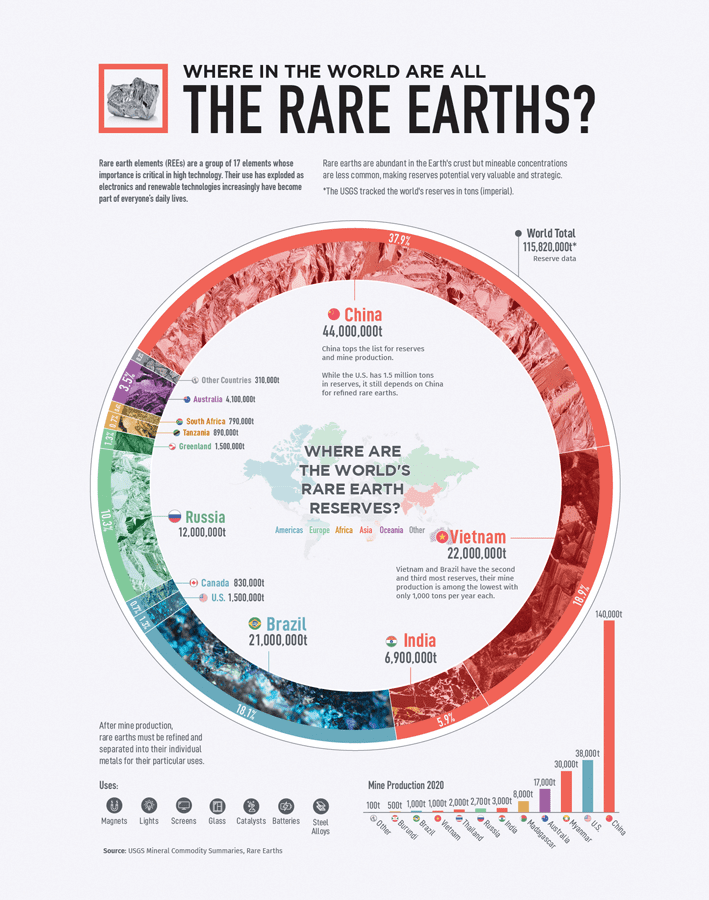Rare earth elements (REE) are a set of 17 elements that are an essential part of many modern-day processes and industries. Some of the most common applications of REEs can be found in electric vehicles (EVs), wind turbines and defense applications. However, many other industries also utilize these REEs, including medical diagnostics, pharmaceutical and agricultural fields.
With many countries looking to move toward more green-powered solutions to fight climate change and pollution, this will require a larger shift toward technologies like EVs. In order to create the permanent magnetic motor in an EV, NdPr, which is a mixture of the REEs Neodymium and Praseodymium, is needed. Combining these two elements creates the strongest magnet known to man and is critical if we are to fully replace internal combustion engines within our lifetime. Along these same lines, REEs are needed to power wind turbines essential for the net zero transition we’re hoping to achieve.
One use of REEs that gets a lot of media coverage is defense applications, and this is mostly because defense programs are government funded, meaning there is funding support in order to secure these elements for use. However, although these defense applications are important, particularly with rising worldwide socio-political concerns, REEs are used in over 200 technological products and, without them, not only would we have to surrender our smart devices and technologies, we also would not be able to hit our environmental targets such as eliminating the internal combustion engine vehicle.
China as a Main Player in REE
China has some of the most significant deposits of REE, with roughly 38 percent of the world’s reserves. For example, China was responsible for 90 percent of all global exports of REE in 2019. Not only this, but it is also the main country to process and refine these materials so they can be used. Consequently, countries like the U.S. have come to rely heavily on China as a producer and refiner of precious REEs – even if that’s not necessarily the most advantageous solution.
In recent years, North America has realized that the dependency on Chinese REEs needs to be curtailed by our own production of these rare earths. However, it takes many years to identify a mineral resource, complete metallurgy analyses, build infrastructure, and create an operating, productive mine. Not to mention, the U.S. currently has no capability of refining the rare earths it mines, so even if it finds more resources, they would still need to be sent to China for processing. Unfortunately, this means that North America, particularly the U.S., will still need to rely on China for REEs in the coming years.
At the same time, many efforts are being made to try and ease the dependence on China, including the Restoring Essential Energy and Security Holdings Onshore for Rare Earths Act of 2022, which essentially forces defense contractors to stop buying rare earths from China by 2026. Although we have already seen a significant decrease in reliance on China, with only about 60 percent of the world’s total REE production coming from China in 2022 compared to 85 percent in 2012, North America still faces massive demands and limited support.
According to the United States Geological Survey (USGS), supply of REEs has more than doubled in the last 10 years, and demand pressures continue to build with all the eco-initiatives North America is looking to implement. For example, the world needs another 200,000 tonnes of REEs in the next 10 years for EV application alone – this is not including other emerging applications such as wind turbines. Another statistic reports that the U.S. would need more than 10 times its current rare earth supplies to reach President Biden’s goal of having 50 percent of cars sold in 2030 be zero-emission EVs.
With such statistics looming overhead, it becomes apparent why we need domestic solutions to this problem. But, with only one REE mine in the U.S., the Mountain Pass (MP) mine in California, which supplied 15.8 percent of the world’s REE production in 2020, it’s not enough to keep up with rising demands. Currently, Defense Metals is the only deposit in North America similar to the MP mine, but emerging producers need ongoing support in order to be successful in the long term.
Ultimately, North America’s dependence on Chinese REEs probably will never fully go away, but it is expected to wane as North America, particularly the U.S. and Canada, identify and integrate domestic solutions to this growing demand.
Dr. Luisa Moreno is the president of Defense Metals Corp. She is a physics engineer, with a PhD in materials science and mechanics from Imperial College London, in the United Kingdom. She is known as a leading analyst in rare earths and has published several reports and articles for the investment community. Dr. Moreno has co-authored a book on mineral processing and project financing, and authored a number of advanced industry and technical reports on several technology minerals.
Oil and gas operations are commonly found in remote locations far from company headquarters. Now, it's possible to monitor pump operations, collate and analyze seismic data, and track employees around the world from almost anywhere. Whether employees are in the office or in the field, the internet and related applications enable a greater multidirectional flow of information – and control – than ever before.



